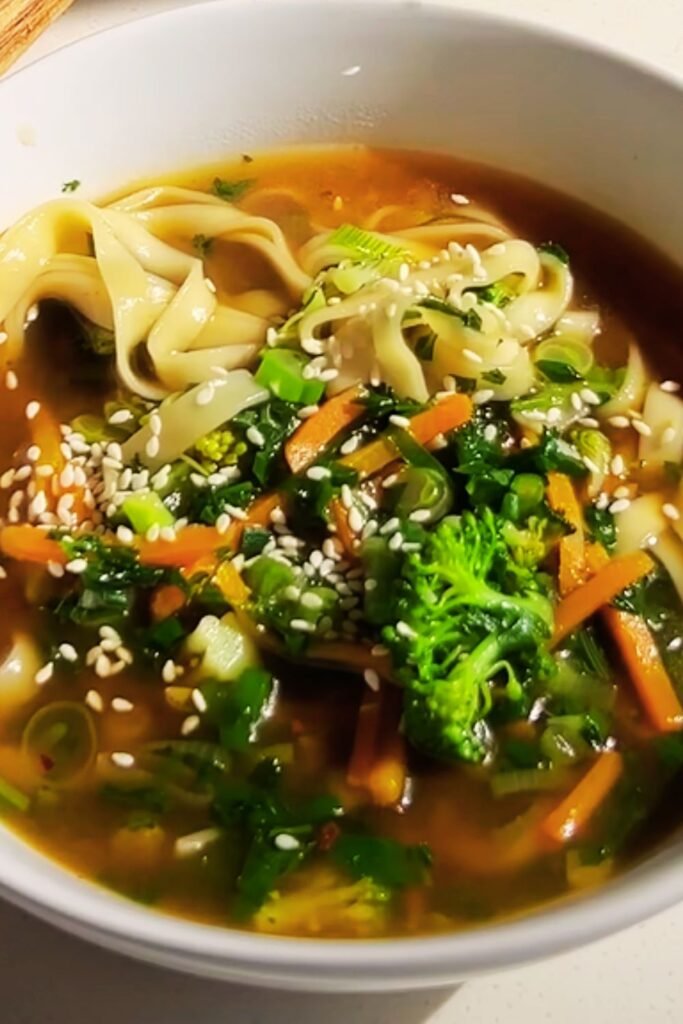When I first discovered the art of making Asian vegetable stock, my cooking transformed completely. Gone were the days of bland, one-dimensional broths that barely enhanced my dishes. Instead, I found myself creating liquid gold that captured the essence of umami, the mysterious fifth taste that makes Asian cuisine so incredibly satisfying.
Asian vegetable stock isn’t just another cooking liquid—it’s the foundation that elevates every dish it touches. Unlike Western vegetable stocks that rely heavily on root vegetables and herbs, Asian vegetable stock incorporates ingredients like kombu seaweed, shiitake mushrooms, and aromatics that have been perfecting Asian cuisine for centuries.
Understanding Asian Vegetable Stock: The Foundation of Flavor
Vegetable Stock: A flavorful liquid made by simmering vegetables, aromatics, and seasonings in water, then straining out the solids to leave behind concentrated flavor.
Umami: Often called the fifth taste, umami provides a savory, meaty depth that makes food more satisfying and complex.
Kombu: A type of edible kelp that’s naturally rich in glutamates, the compounds responsible for umami flavor.
Dashi: A traditional Japanese stock made primarily from kombu and bonito flakes, though vegetarian versions use only kombu and mushrooms.
The beauty of Asian vegetable stock lies in its complexity. While I could simply throw some carrots, celery, and onions into a pot, the Asian approach involves layering flavors that complement each other in ways that Western cooking traditions don’t typically explore.
Essential Ingredients for Ultimate Asian Vegetable Stock

Primary Umami Builders
Dried Shiitake Mushrooms: These provide incredible depth and that distinctive earthy flavor that makes Asian stocks so satisfying. I always keep a jar of these in my pantry because they’re absolutely essential.
Kombu Seaweed: This is your secret weapon for natural umami. Just one piece can transform ordinary water into something extraordinary.
Dried Wood Ear Mushrooms: These add subtle flavor and interesting texture elements to your stock.
Aromatic Foundation
Fresh Ginger: I use about 2-3 inches of fresh ginger, sliced into coins. The warming spice cuts through richness and adds brightness.
Garlic: Whole cloves work best—I typically use 6-8 cloves depending on how garlicky I want the final product.
Green Onions: Both white and green parts contribute different flavor notes throughout the cooking process.
Lemongrass: If you can find it, lemongrass adds a subtle citrusy note that makes the stock more complex.
Vegetable Components
| Vegetable | Quantity | Purpose | Preparation |
|---|---|---|---|
| Carrots | 2 large | Natural sweetness, body | Roughly chopped |
| Daikon Radish | 1 cup | Mild peppery note | Sliced into rounds |
| Napa Cabbage | 4-5 leaves | Subtle vegetable base | Roughly chopped |
| Corn Cobs | 2 cobs | Natural sweetness | Cut into pieces |
| Onion | 1 large | Aromatic foundation | Quartered |
Seasoning Elements
Soy Sauce: I add this toward the end of cooking to control sodium levels and enhance the umami profile.
Mirin: A sweet rice wine that adds subtle sweetness and depth.
Sake: Optional, but it adds complexity and helps extract flavors from other ingredients.
My Step-by-Step Method for Perfect Asian Vegetable Stock
Preparation Phase (15 minutes)
- Soak the dried mushrooms: I place my shiitake mushrooms in warm water for about 15 minutes until they’re soft and pliable. Don’t discard this soaking liquid—it’s liquid gold that goes straight into the stock pot.
- Prepare your vegetables: Rough chopping is perfectly fine here. You’re going to strain everything out anyway, so don’t worry about precise cuts.
- Clean your kombu: Gently wipe the kombu with a damp cloth to remove any grit, but don’t wash it aggressively—you want to preserve those natural flavor compounds on the surface.
Building the Flavor Base (20 minutes)

- Start with cold water: I use about 12 cups of cold, filtered water in my largest stock pot. Cold water helps extract flavors more gradually.
- Add the kombu first: This goes in with the cold water. I let it sit for about 10 minutes before turning on the heat. This cold extraction method pulls out more subtle flavors.
- Heat gradually: I bring the water to just below a simmer—you should see tiny bubbles forming on the bottom of the pot, but not a rolling boil.
- Remove the kombu: Once the water is hot but before it boils, I remove the kombu. Boiling kombu can make your stock bitter and slimy.
The Long Simmer (2-3 hours)
- Add mushrooms and soaking liquid: In go the rehydrated shiitakes along with their soaking liquid.
- Add aromatics: Ginger, garlic, green onions, and lemongrass join the party.
- Include vegetables: All your chopped vegetables go in now.
- Maintain gentle simmer: This is crucial—a rolling boil will make your stock cloudy and can extract bitter compounds. I keep it at the gentlest simmer possible.
Final Seasoning and Straining (30 minutes)
- Taste and adjust: After 2-3 hours, I taste the stock and add soy sauce, mirin, or sake as needed.
- Final simmer: Let those seasonings meld for another 15-20 minutes.
- Strain carefully: I use a fine-mesh strainer lined with cheesecloth to get the clearest possible stock.
Detailed Nutritional Profile and Storage Information
| Component | Per Cup (240ml) | Daily Value % | Benefits |
|---|---|---|---|
| Calories | 15-20 | <1% | Low-calorie flavor base |
| Sodium | 200-400mg | 8-17% | Varies by soy sauce amount |
| Potassium | 150-200mg | 4-6% | Supports heart health |
| Vitamin A | 2000-3000 IU | 40-60% | From carrots and vegetables |
| Vitamin C | 8-12mg | 13-20% | From fresh vegetables |
| Iron | 0.5-1mg | 3-6% | From mushrooms and seaweed |
| Calcium | 20-30mg | 2-3% | From kombu seaweed |
Storage Guidelines
Refrigerator Storage: My finished stock keeps for up to 5 days in the refrigerator in airtight containers.
Freezer Storage: I portion stock into ice cube trays or freezer bags for up to 6 months. Ice cube portions are perfect for stir-fries and quick soups.
Preservation Tips: Always cool stock completely before refrigerating, and never leave it at room temperature for more than 2 hours.
Creative Variations and Regional Adaptations
Korean-Style Vegetable Stock
For Korean dishes, I add dried kelp (dashima), dried anchovies (for pescatarians), and sometimes a small piece of dried daikon. The result is perfect for kimchi jjigae or any Korean soup base.
Chinese-Style Variation
I incorporate dried lotus root, dried lily buds, and sometimes a small amount of Shaoxing wine. This version works beautifully in hot pot broths and Chinese soups.
Japanese-Style Dashi Alternative
Focusing heavily on kombu and shiitake, with minimal other vegetables, creates a cleaner, more refined stock perfect for miso soup and delicate Japanese dishes.
Southeast Asian Twist
Adding galangal instead of ginger, kaffir lime leaves, and lemongrass creates a stock that’s perfect for Thai and Vietnamese soups.
Troubleshooting Common Stock-Making Issues

Cloudy Stock: This usually happens from boiling too vigorously. Keep that simmer gentle, and strain through cheesecloth for clarity.
Bitter Flavor: Often caused by leaving kombu in too long or boiling it. Remove kombu before the water reaches a full simmer.
Weak Flavor: You might need more mushrooms or longer simmering time. Don’t be afraid to add more dried shiitakes.
Too Salty: If you’ve added too much soy sauce, dilute with plain water and adjust other seasonings accordingly.
Lack of Umami: More mushrooms and a longer simmer usually solve this. Sometimes I add a tiny amount of mushroom powder.
Creative Uses for Your Asian Vegetable Stock
The versatility of this stock continues to amaze me. Here are my favorite applications:
Soup Bases: It’s perfect for miso soup, hot and sour soup, or any Asian-inspired soup recipe.
Rice Cooking: I substitute this stock for water when making rice, creating incredibly flavorful rice that stands alone as a side dish.
Stir-Fry Liquid: Instead of adding water to stir-fries, I use small amounts of this stock for extra depth.
Braising Liquid: It makes an excellent base for braising vegetables or tofu.
Noodle Soup Broths: Ramen, pho, or any noodle soup benefits enormously from this flavorful foundation.
Advanced Techniques for Stock Perfection
Double-Stock Method
Sometimes I make stock with stock—using my finished vegetable stock as the liquid base for another round of vegetable extraction. This creates an intensely flavored concentrate that I dilute as needed.
Pressure Cooker Adaptation
While I prefer the traditional method, you can make this stock in a pressure cooker in about 45 minutes. Use the same ingredients but reduce liquid by about 25% since there’s less evaporation.
Roasting for Depth
Occasionally, I roast the vegetables before adding them to the pot. This caramelization adds another layer of complexity, though it does darken the final stock.
Pairing Your Stock with Different Cuisines
| Cuisine Type | Best Stock Variation | Recommended Uses | Flavor Notes |
|---|---|---|---|
| Japanese | Kombu-heavy version | Miso soup, dashi substitute | Clean, oceanic |
| Chinese | Shiitake-forward blend | Hot pot, soup bases | Rich, earthy |
| Korean | Dashima-based | Kimchi stew, Korean soups | Slightly funky, deep |
| Thai | Lemongrass-infused | Tom kha, curry bases | Bright, aromatic |
| Vietnamese | Ginger-heavy version | Pho broth, Vietnamese soups | Warming, clean |
Questions and Answers
Q: How long can I store homemade Asian vegetable stock? I keep mine in the refrigerator for up to 5 days, or freeze it for up to 6 months. I always label containers with the date because time flies when you’re busy cooking.
Q: Can I make this stock without kombu seaweed? While kombu provides irreplaceable umami, you can substitute with extra dried mushrooms and a small amount of soy sauce. The flavor won’t be identical, but it’ll still be delicious.
Q: Is it normal for the stock to gel when cold? Some gelling can occur from the natural pectin in vegetables, but it won’t be as pronounced as meat-based stocks. This is completely normal and actually indicates good extraction.
Q: Can I reuse the vegetables after straining? I don’t recommend it for eating since most nutrients and flavors have been extracted, but they make excellent compost material.
Q: What’s the difference between this and regular vegetable stock? The key differences are the umami-rich ingredients like kombu and shiitake mushrooms, plus Asian aromatics like ginger and lemongrass. These create a more complex, satisfying flavor profile.
Q: Should I salt the stock during cooking? I prefer to add salt (via soy sauce) toward the end of cooking. This gives me better control over the final sodium level and prevents over-concentration during the long simmer.
Q: Can I make a smaller batch? Absolutely! Just scale down all ingredients proportionally. I sometimes make half-batches when I’m cooking for fewer people.
Q: Why remove the kombu before boiling? Boiling kombu can release compounds that make the stock bitter and give it an unpleasant slimy texture. Gentle heating extracts the good flavors without the negatives.
Q: How do I know when the stock is done? The stock is ready when it has a rich, complex flavor that tastes much more intense than the sum of its parts. This usually takes 2-3 hours of gentle simmering.
Q: Can I add other Asian ingredients like star anise or five-spice? You can, but I’d suggest making the basic version first to understand the fundamental flavors. Then experiment with additions in small batches to see what you like.
Making Asian vegetable stock has become one of my most reliable cooking foundations. The time investment pays off tremendously when you taste the difference it makes in your cooking. Start with this basic recipe, then let your taste preferences guide you toward your own perfect variation. The journey of discovering these deep, complex flavors is just as rewarding as the destination.